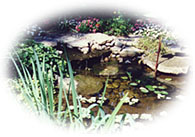TIPS BEFORE YOU START:
- Choose a level site in a sunny, open location, preferably where it can be easily viewed from the house or patio.
- Keep pond away from over-hanging trees and falling leaves. The fallen leaves will rot in the pond and tree roots may puncture the pond liner.
- Check with utility companies to make sure it is safe to dig in your site location.
- Choose a place near water and electrical G.F.I. outlets.
- Make sure the depth is adequate if you intend on over-wintering fish.
Building a pond with a liner:
Flexible liners can be easily shaped and sized to fit your needs and provide a natural look. Buy the heaviest liner available. We recommend Laguna Durashield liners made of fish and plant friendly, 45-mil, 2-ply, multi-grain EPDM rubber, guaranteed for 20 years.
A common mistake is to make a pond too small. If you want clear water and cool water temperatures, the pond should be at least 6 ft. x 4 ft. x 24 in. deep (1.8 m x 1.2 m x 60 cm). This is the minimum size to consider if you plan to keep fish and plants.
HOW TO CALCULATE THE REQUIRED LINER SIZE
- Determine the maximum length, width and depth of your pond.
- Double the depth and add it to both the length and width values.
- Add an additional 2 ft. (60 cm) to both the width and length determined above to account for shelves and overlap at the pond edge.
Example:
If you want a pond that's 6 ft. X 8 ft. X 2 ft. deep (2 m x 2.5 m x 60 cm), you'll need a liner that's 12 ft. x 14 ft. (about 3.7 m x 4.3 m).
HOW TO CALCULATE THE NUMBER OF GALLONS OF WATER IN A POND
RECTANGULAR & SQUARE PONDS:
Length x Width x Average Depth x 7.5 = TOTAL GALLONS
ROUND PONDS:
0.785 x (Top x Bottom Diameter x Depth) x 7.5 = TOTAL GALLONS.
IDEAL FLOW RATE FOR POND: Pond water should circulate every 2 hours. Minimum pump flow rate capacity required is the total gallons of water in pond, divided by 2 = GPH flow rate.
|
|
|
- Outline the shape of the pond using pegs and string or a garden hose.
- Dig out the hole using the outline as a guide.
- Dig down 9 inches (23 cm) at a gently sloping angle.
- If you plan to grow plants along the edges, cut out a 9 inch (23 cm) wide shelf.
- Continue digging until you reach the desired depth.
|
TIP:
Design your pond with large open curves and flowing lines. Avoid narrow channels that can block water flow.
TIP:
Slope the sides inward at a 20° angle to prevent cave-ins. In the winter, a slope allows ice to expand upwards without causing damage.
This calculation gives you enough material to line the sides, shelves and to overlap the edges.
(Depth x 2) + Width + 2 = Liner Width
(Depth x 2) + Length + 2 = Liner Length
|
|
|

|
- Use a two-by-four and a level to make sure that the hole is level.
- Check that there are no stones or roots to puncture the liner.
- Spread a 1 inch (2.5 cm) layer of damp sand in the hole.
- Cover with a layer of old carpet or matting.
- Place the liner evenly across the hole.
- Let the center of the liner touch the base and shelf edges.
- Anchor the overlap with concrete blocks or stones.
|
| TIP:
Make sure that the rim of the pool is level across both the length and width, otherwise the pond will turn out lopsided and unattractive.
TIP:
Spreading the liner out in the sunshine makes the material more flexible and easier to handle. Do not do this over the lawn, it may damage the grass. |
|
|

|
- Fill the pond with water slowly.
- The liner will stretch and adapt to the shape of the pond under the weight of the water.
- Adjust the stones and tug the edges of the liner to form neat folds as it starts to crease.
- Creases will hardly be visible once the pond is full.
|
| TIP:
Mix the excavated soil with topsoil to create a rock garden or the base of a waterfall feature.
TIP:
Be careful not to let the liner twist or stretch too much when filling the pond. Too much stress can cause the liner to rip or puncture. |
|
|

|
- When the pond is full, trim off any excess liner, leaving an overlap of at least 6 inches (15 cm).
- Cover the overlap with rocks, turf or paving stones.
|
| TIP:
If you place slabs or stones along the edge of the pond, let them overhang the edge slightly to hide the liner.
|
STARTER SHOPPING LIST
FOR LINER POOL
|
| |
Black Pond Liner |
| |
Sand for backfilling |
| |
Old carpet or commercial pond matting |
| |
Water Prep Water Treatment |
| |
PowerJET Pond Pump |
| |
PowerFLO Pond Filter |
| |
Plants |
| |
Plant Baskets |
| |
Aquatic Loam |
| |
Plant Food |
| |
Books |





















